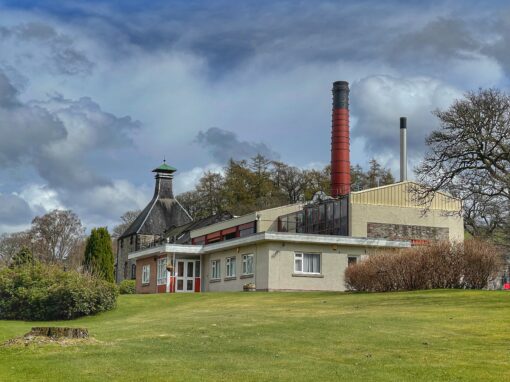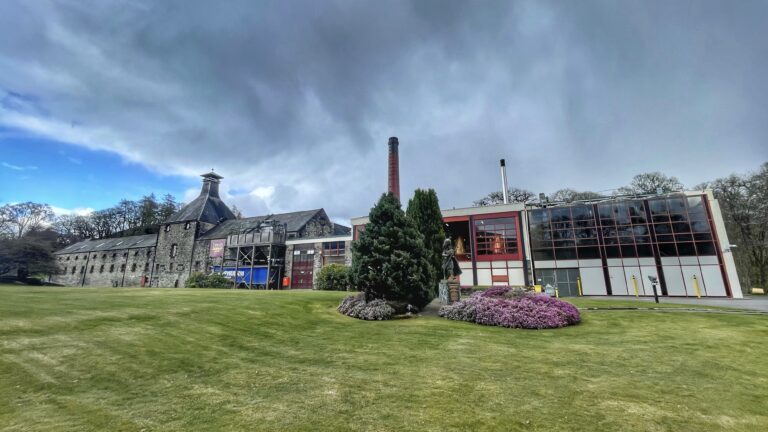A Trip to Aberfeldy
Islay Whisky Academy Kinship Host, Neill Murphy, reflects on a visit to Dewar’s Aberfeldy Distillery in Highland Perthshire.

Scotch whisky is at its finest when it reflects something of the place it comes from. The landscape, the climate, the people, the culture, the history… all these elements play a role in shaping the character of the whisky. You need only look to the malts of Islay for confirmation of this. They seem to capture the essence of their home, perhaps more than any other spirit in the world. This sense of place and of provenance is part of what makes single malt Scotch so appealing and a good distillery tour can help us understand all these different influences on the creative process.
The bond between spirit and place is romantic and evocative. It helps us to connect with the spirit in a deeper way. It’s perhaps telling that we tend not to feel the same about blended Scotch, despite many brands being just as steeped in history as the malts. By their very nature, however, blends lack a sense of place. They lack a connection to a location. They lack a unique cultural identity. Some blenders have sought to tackle this by linking their brands with a distillery, often one that contributes to the make-up of the blend. Success in combining blend and distillery hasn’t always come easy, though. Glenturret was The Famous Grouse Experience for a while but that connection was broken with a recent change in ownership. Blair Athol was home of Bell’s for a while but little seems to have been made of that link.

More recently, Diageo has given Johnnie Walker an impressive home in Edinburgh, something which makes little sense in terms of the brand’s history but lots of sense in terms of courting tourist money. As part of the same project, four distilleries across Scotland were given a Visitor Centre facelift. Clynelish, Cardhu, Glenkinchie and Caol Ila now represent the Four Corners of Johnnie Walker. I can’t comment on their success, not having done the respective tours but certainly the new visitor centre at Caol Ila is an improvement on what went before. Still, there seems a difficult balancing act between telling the tale of the distillery and using it to promote a blend. Do people come to Islay to hear the story of the Kilmarnock grocer who became the most famous name in whisky? Interesting tale though it may be, I’m not sure that they do.
Aberfeldy Distillery, on the other hand, seems to have got the balance just about right. As well as being a working malt distillery, it’s home to Dewar’s World of Whisky, a visitor centre and museum that tells the story of John Dewar & Sons – and their involvement with Aberfeldy. Therein lies the key to the success of the place. John Dewar was born in a croft a couple of miles down the road. As a young man he sought his fortune by walking to Perth and eventually became successful at selling whisky to a population that was infatuated with brandy and rum. When John passed away, his business was taken over by his sons, Tommy and John Jr. The brothers needed a regular supply of malt whisky to keep up with increased demand for their blend, so they decided to build a distillery, establishing Aberfeldy in 1896. It continues to produce spirit for the Dewar’s blend to this day. A Dewar’s brand home at Aberfeldy makes complete sense, therefore. Not only does the malt feature prominently in the blend, but the Dewars built the place with the specific intention of using it in that way. The distillery and blend have always been linked and you cannot tell the story of Aberfeldy, without also telling the story of John Dewar & Sons.
Beyond the link to Dewar’s Blended Scotch, Aberfeldy is, in its own right, a decent single malt. It’s on the gentle side, something which us Islay-loving peatheads can take a little time to acclimatise to but the spirit is not without its charms. Best of all, it seems to make sense in its landscape. The malts of Islay are smoky, coastal and bold. They reflect the dramatic, Atlantic-lashed frontier that produced them. Aberfeldy is mellow, gentle and sweet, reflecting the rolling green hills, glittering rivers and trickling waterfalls of Highland Perthshire. The malt feels like it belongs there.
The distillery makes for a rather unique tour experience that combines the tale of both malt and blend. Rather than detracting from the story of the location, the prominence of the blend feels significant to it. Indeed, it’s through the showcasing of the founders and their product that we understand how and why Aberfeldy came about and by learning about John Dewar and his descendants, we understand why the malt seems so much of the location. When people are rooted in the landscape, community and culture, it seems inevitable that they will create a whisky that captures the essence of the place. Thus it was with the Dewars. They created a malt that was always destined to sit at the heart of a blend yet still stands on its own as a representation of its Highland Perthshire home.




